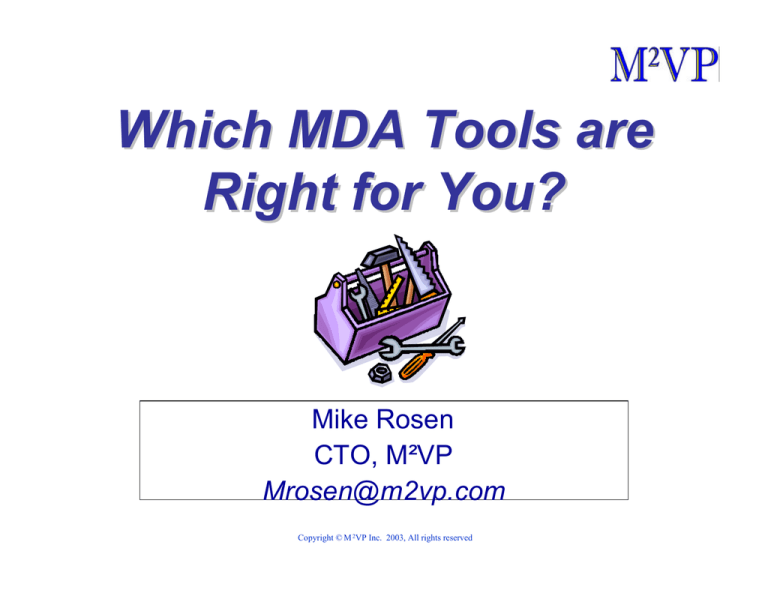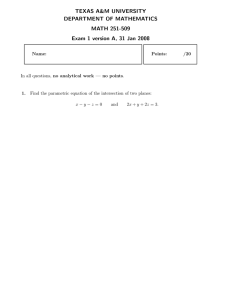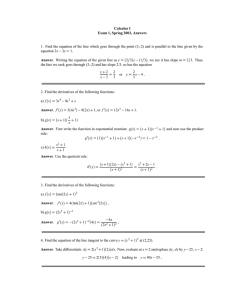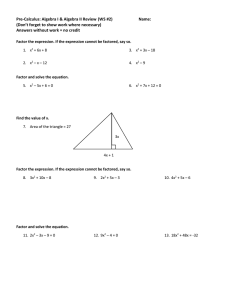
Which MDA Tools are
Right for You?
Mike Rosen
CTO, M²VP
Mrosen@m2vp.com
Copyright © M 2VP Inc. 2003, All rights reserved
Model Driven Architecture
§ A set of standards
defining the scope,
content, creation and
usage of models
§ An architecture-based
process for integrating
models into the
development process
§ Core Technologies
– UML + OCL
– MOF + XMI
– CWM
Copyright © M 2VP Inc, 2003, All rights reserved
Slide 2
Agenda
§
§
§
§
§
§
§
MDA context
Development process
Where tools fit in the process
Requirements for tools
Integration between tools
Advanced Topics
ROI
Copyright © M 2VP Inc, 2003, All rights reserved
Slide 3
MDA Distilled
Business Model
(CIM)
Business Analyst
Platform Independent
Analysis Model
(PIM)
Architect / Designer
Developer / Tester
Copyright © M 2VP Inc, 2003, All rights reserved
Platform Specific
Design Model
(PSM)
Code
Slide 4
MDA Mappings
Computation Independent
Business Model
PIM
PIM Mapping
Platform Independent
Analysis Model
PIM
PSM Mapping
Platform Specific
Design Model
PSM
PSM Mapping
Code
PSM
Copyright © M 2VP Inc, 2003, All rights reserved
Code Mapping
Slide 5
Technology Independence
§
Business Model
§
Business Analyst
Platform Independent
Model
Architect / Designer
§
Applications are “FutureProof” against technology
churn
When technology
evolves, a new PSM can
be generated rather than
rewriting it
Artifacts can be
generated for multiple
platforms from the same
design
EJB 1.1
Design Model
EJB 2.0
Design Model
Developer
Copyright © M 2VP Inc, 2003, All rights reserved
.NET
Design Model
Slide 6
Generation Tools
§
§
Business Model
Business Analyst
§
Platform Independent
Model
§
Tools are standards
based, not proprietary
Resulting code base
doesn’t require a specific
runtime infrastructure
70-80% of the structural
code can be generated
Test Cases can be
generated from OCL
Architect / Designer
Model Transformation Tool
Platform Specific Model
Code Generation Tool
Developer / Tester
Copyright © M 2VP Inc, 2003, All rights reserved
Code
Test Generation Tool
Slide 7
M²VP 4 Stage MDA Process
1. Define the approach
–
Integrate enterprise architecture and standards into the
development process.
Ø
Create meta-models and profiles
2. Define the problem
Ø
Create Business Models (Domain, CIM, System)
3. Define the solution
Ø
Refine into PIMs and PSMs
4. Leverage the solution
–
Integrate assets into a corporate reuse program and repository
–
Architecture and design accommodates: reuse, customization,
enhancements, versioning…
Copyright © M 2VP Inc, 2003, All rights reserved
Slide 8
MDA Profiles
§ Computational Independent Model
– Simplified UML subset appropriate for business
analysts. Incorporates GRM
§ Platform Independent Model
– Custom profiles for enterprise architecture and
standards
– Standard based profiles (EDOC, EAI)
§ Platform Specific Model
– Standards based profiles (CORBA, EJB, .NET)
Copyright © M 2VP Inc, 2003, All rights reserved
Slide 9
MDA Process Review
Business Model
Business Analyst
Meta & Modeling
MDA Architect
Platform Independent
Model
Application Architect
Model Transformation
Platform Specific Model
Code, Test, Doc
Generation
Developer / Tester
Copyright © M 2VP Inc, 2003, All rights reserved
Code
Slide 10
Meta and Modeling Concerns
§ Ability to create models and meta-models
in UML
– Formally define model constructs and constraints
§ Ability to create profiles in UML
– Since most modeling tools don’t support MOF
directly, profiles extend standard UML tools
§ Ability to validate correctness of model
against meta-model
§ Ability to import / export meta-models and
models in standard XMI format
Copyright © M 2VP Inc, 2003, All rights reserved
Slide 11
Transformation Concerns
§ Ability to formally define mapping between
models
§ Ability to customize standard mappings
§ Ability to parameterize mappings
§ Ability to modify transformation result
§ Ability to trace elements in one model to
the elements the were derived from in
another model
Copyright © M 2VP Inc, 2003, All rights reserved
Slide 12
Generation Concerns
§ Preserves separation of concerns
– Platform specific info is not required in PIM
– Platform independent info in not required in PSM
§
§
§
§
Can generate to multiple technologies and platforms
Generation can be parameterized and modified
Generation based on standard and custom patterns
Completeness
– Structural code (stubs, etc.)
– Procedural code
– OCL can be compiled, generate run-time code
§ Can be integrated into an automatic build process
(command driven)
Copyright © M 2VP Inc, 2003, All rights reserved
Slide 13
More About Generation
§ Procedural code
– Some code can be generated from OCL, but
– Requires support for Action Semantics and Language
– Generally necessitates reducing scope of target and
environment
§ Tests
– Can be generated from OCL and (Action Language)
– Can be integrated into a framework (e.g. JTEST, JRUN)
§ Documentation
– Ability to create analysis and design documentation from
information in all levels of models
– Ability to customized document and report generation
– Ability to create some form of user documentation
Copyright © M 2VP Inc, 2003, All rights reserved
Slide 14
Advanced Capabilities
§ Model correctness can be validated
against meta-model
§ Model can execute in a simulation
environment
§ Support for versioning of models
§ Support for model synchronization
– Reverse or Round-Trip engineering
§ Support for XMI/JMI programming
§ MOF Repository
§ Support for CWM
Copyright © M 2VP Inc, 2003, All rights reserved
Slide 15
Metadata in the MDA Process
Business Model
Platform Independent
Model
Platform Specific Model
Code
Profiles
CIMs
PIMs
PSMs
Asset
Descriptors
Deploy.
Descr. +
Declarative
Source
Code
Docs
MOF/UML
UML/RAS
XML
scms
dms
Mappings
MOF
Copyright © M 2VP Inc, 2003, All rights reserved
Slide 16
Tools in the MDA Process
Business
Modeling
Documentation
Generation
Business Model
Business Analyst
Modeling,
Validation &
Simulation
Platform Independent
Model
Profiles
&
MDA Architect
Mappings
Application Architect
MetaModeling
Model
Transformation
Repositories
+ Metadata
Management
MOF
Platform Specific Model
Code Generation
Developer / Tester
MOF/UML
Copyright © M 2VP Inc, 2003, All rights reserved
Code
Test Generation
UML/RAS
XML
scms
dms
Slide 17
MDA Tool Integration
Business Modeling Tool
XMI
I
XM
XMI
Business Model
XM
I
Business Analyst
Meta-Modeling Tool
Software Modeling Tool
MDA Architect
I
XM
Platform Independent
Model
Transformation Tool
Application Architect
I
XM
Platform Specific Model
Developer / Tester
Code and Test
Generation Tool
Code
XMI
Copyright © M 2VP Inc, 2003, All rights reserved
Repository and
Metadata Mgmt. Tool
Slide 18
Hard Criteria
§ Meets YOUR criteria
§ Addresss Full Lifecycle
– Meta-models, transformations, generation
§ Generation
– SOC, Customization, Completeness
§ Advanced Capabilities
– Synchronization, Versioning, Validation, Simulation, MOF
§ Integration with other tools
– Modeling
– IDE
– Repository
§ Standards Conformance
Copyright © M 2VP Inc, 2003, All rights reserved
Slide 19
Soft Criteria
§ Cost
§ Product Architecture
– Evolvability with the market
– Support for future platforms
§ Documentation, samples, training
§ Ease of Use
§ Company
–
–
–
–
Support, enhancements
Future looks bright
Product line is integral
Easy to work with
Copyright © M 2VP Inc, 2003, All rights reserved
Slide 20
MDA ROI Opportunities
§ By reduced production and operation costs
– Development automation
– Improved quality
– Improve utilization through reuse initiatives
§ For MDA to deliver ROI
– We must make models first class development
artifacts. Tools must support all aspects of this.
§ Code generation is currently biggest focus
§ Profiles, transformations, etc.
– Less perceived value, less understood
– No metrics to determine relative importance
Copyright © M 2VP Inc, 2003, All rights reserved
Slide 21
Conclusion
§
§
§
§
No one tool does it all!
Enterprises have different requirements
Integration and customization important
Standards and tools are critical to MDA
success
§ Lot’s of advancements in the future
– Action Semantics, MOF 2.0, CWM, RT Engineering
§ The market is still young. Expect…
§ Continued expansion of MDA tools…
§ … and then contraction of market
Copyright © M 2VP Inc, 2003, All rights reserved
Slide 22
What’s Wrong with ROI?
§ Latest buzzword
§ Gimmicky “calculator” on web site
§ Encourages short term measurement,
within the scope of a single project
§ IT value needs to be measured based on
total cost of ownership (TCO) and less
tangible measures such as efficiency,
strategic impact, risk, etc.
Copyright © M 2VP Inc, 2003, All rights reserved
Slide 23
Return on Assets
§ Return On Assets is a strategic alternative
which focuses on building value by
increasing productivity of assets
§ IT focus shifts from improved transaction
capability to improved business processes
to improved strategic initiatives
§ Focus shifts from costs containment to
opportunity capture
Copyright © M 2VP Inc, 2003, All rights reserved
Slide 24
Questions
Copyright © M 2VP Inc. 2003, All rights reserved




